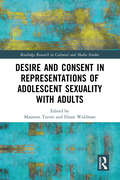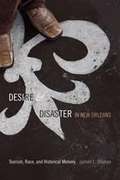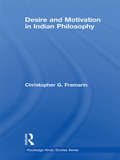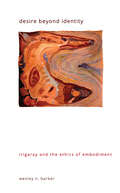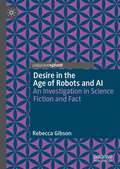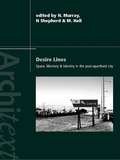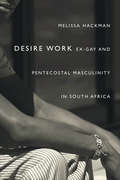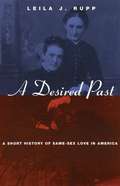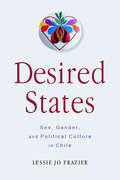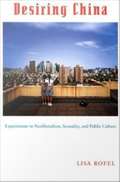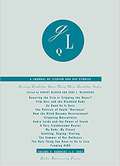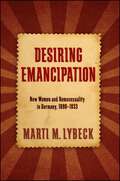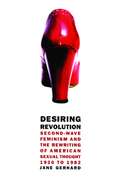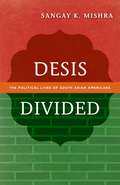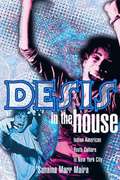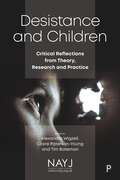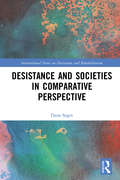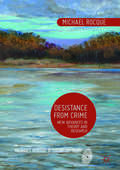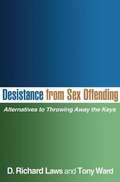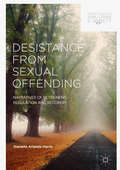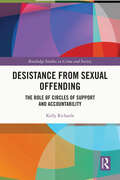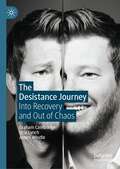- Table View
- List View
Desire and Consent in Representations of Adolescent Sexuality with Adults (Routledge Research in Cultural and Media Studies)
by Maureen Turim Diane WaldmanThis book presents an innovative comparative view of how the issue of adolescent sexuality and consent is differently treated in various media. Analyzing teenage sexual encounters with adults across a variety of media, including films, television, novels, and podcasts, the volume takes a positive stance on the expression of teenage sexuality, while remaining sensitive to the power of adults to abuse and manipulate. The anthology treats these representations as negotiations between conflicting forces: desire, sexual self-knowledge, unequal power, and the law, the latter both actual legal statutes and internalized law in the philosophical and psychoanalytic sense. Questions of unequal power inherent in such relations are theorized. The authors examine variations of this configuration of sexual relations between teenagers and adults from different perspectives, to consider how various forms of expression rework it formally. These essays are attuned to both nuances of presentation and contexts of reception, and they consider how aesthetics play a role. Contributing to the general debate about the ways that societies construct and regulate adolescent sexuality, this book will be of great interest to scholars and students of media studies, cultural studies, film studies, television studies, sociology, and gender studies
Desire and Disaster in New Orleans: Tourism, Race, and Historical Memory
by Lynnell L. ThomasMost of the narratives packaged for New Orleans's many tourists cultivate a desire for black culture--jazz, cuisine, dance--while simultaneously targeting black people and their communities as sources and sites of political, social, and natural disaster. In this timely book, the Americanist and New Orleans native Lynnell L. Thomas delves into the relationship between tourism, cultural production, and racial politics. She carefully interprets the racial narratives embedded in tourism websites, travel guides, business periodicals, and newspapers; the thoughts of tour guides and owners; and the stories told on bus and walking tours as they were conducted both before and after Katrina. She describes how, with varying degrees of success, African American tour guides, tour owners, and tourism industry officials have used their own black heritage tours and tourism-focused businesses to challenge exclusionary tourist representations. Taking readers from the Lower Ninth Ward to the White House, Thomas highlights the ways that popular culture and public policy converge to create a mythology of racial harmony that masks a long history of racial inequality and structural inequity.
Desire and Domestic Fiction: A Political History of the Novel
by Nancy ArmstrongA foundational work of literary criticism dealing with the Victorian novel, sexuality, and the rise of the middle class.
Desire and Motivation in Indian Philosophy (Routledge Hindu Studies Series)
by Christopher G. FramarinDesireless action is typically cited as a criterion of the liberated person in classical Indian texts. Contemporary authors argue with near unanimity that since all action is motivated by desire, desireless action is a contradiction. They conclude that desireless action is action performed without certain desires; other desires are permissible. In this book, the author surveys the contemporary literature on desireless action and argues that the arguments for the standard interpretation are unconvincing. He translates, interprets, and evaluates passages from a number of seminal classical Sanskrit texts, and argues that the doctrine of desireless action should indeed be taken literally, as the advice to act without any desire at all. The author argues that the theories of motivation advanced in these texts are not only consistent, but plausible. This book is the first in-depth analysis of the doctrine of desireless action in Indian philosophy. It serves as a reference to both contemporary and classical literature on the topic, and will be of interest to scholars of Indian philosophy, religion, the Bhagavadgita and Hinduism.
Desire beyond Identity: Irigaray and the Ethics of Embodiment (SUNY series in Gender Theory)
by null Wesley N. BarkerCritically adapts the notion of desire in Luce Irigaray's philosophy to rethink the role of embodiment in sociopolitical and philosophical discourses today.Arguing for a radical return to desire in Luce Irigaray's thought, this book decisively intervenes in impasses around questions of identity that continue to confound contemporary discourse and politics. By prioritizing the disruptive potential of desire rather than sexual difference, Wesley N. Barker extends Irigaray's relational theory of becoming into new territory, opening generative, often surprising pathways for conversation with philosophies of race, queer theory, political theology, decolonial theory, and posthuman thought. As a source for reimagining materiality, desire is pulled free of a phallocentric, white, colonial framework and mobilized toward a philosophy of living capable of addressing the twenty-first century's multifaceted crises of identity, representation, and embodiment.
Desire in the Age of Robots and AI: An Investigation in Science Fiction and Fact
by Rebecca GibsonThis book examines how science fiction’s portrayal of humanity’s desire for robotic companions influences and reflects changes in our actual desires. It begins by taking the reader on a journey that outlines basic human desires—in short, we are storytellers, and we need the objects of our desire to be able to mirror that aspect of our beings. This not only explains the reasons we seek out differences in our mates, but also why we crave sex and romance with robots. In creating a new species of potential companions, science fiction highlights what we already want and how our desires dictate—and are in return recreated— by what is written. But sex with robots is more than a sci-fi pop-culture phenomenon; it’s a driving force in the latest technological advances in cybernetic science. As such, this book looks at both what we imagine and what we can create in terms of the newest iterations of robotic companionship.
Desire Lines: Space, Memory and Identity in the Post-Apartheid City (Architext)
by N. Murray N Shepherd M. HallThis ground breaking new work draws together a cross-section of South African scholars to provide a lively and comprehensive review of the under-researched area of heritage practice following the introduction of the National Heritage Resources Act. Looking at the daily heritage debates, from naming streets to projects such as the Gateway to Robben Island, Desire Lines addresses the innovative strategies that have emerged in the practice of defining, identifying and developing heritage sites. In a unique multi-disciplinary approach, contributions are featured from a broad spectrum of fields, including the built environment and public culture and education. Showcasing work from tour operators and museum curators alongside that of university-based scholars, this book is a comprehensive and singularly authoritative volume that charts the development of new and emergent public cultures in post-apartheid South Africa through the making and unmaking of its urban spaces. This pioneering collection of essays and case studies is an indispensable guide for those working within or studying heritage practice.
Desire Work: Ex-Gay and Pentecostal Masculinity in South Africa
by Melissa HackmanIn postapartheid Cape Town—Africa's gay capital—many Pentecostal men turned to "ex-gay" ministries in hopes of “curing” their homosexuality in order to conform to conservative Christian values and African social norms. In Desire Work Melissa Hackman traces the experiences of predominantly white ex-gay men as they attempt to forge a heterosexual masculinity and enter into heterosexual marriage through emotional, bodily, and religious work. These men subjected themselves to daily self-surveillance and followed prescribed behaviors such as changing how they talked and walked. Ex-gay men also saw themselves as participating in the redemption of the nation, because South African society was perceived as suffering from a crisis of masculinity in which the country lacked enough moral heterosexual men. By tying the experience of ex-gay men to the convergence of social movements and public debates surrounding race, violence, religion, and masculinity in South Africa, Hackman offers insights into the construction of personal identities in the context of sexuality and spirituality.
A Desired Past: A Short History of Same-Sex Love in America
by Leila J. RuppeWith this book, Leila J. Rupp accomplishes what few scholars have even attempted: she combines a vast array of scholarship on supposedly discrete episodes in American history into an entertaining and entirely readable story of same-sex desire across the country and the centuries. "Most extraordinary about Leila J. Rupp's indeed short, two-hundred-page history of 'same-sex love and sexuality' is not that it manages to account for such a variety of individuals, races, and classes or take in such a broad chronological and thematic range, but rather that it does all this with such verve, lucidity, and analytical rigor. . . . [A]n elegant, inspiring survey." —John Howard, Journal of American History
Desired States: Sex, Gender, and Political Culture in Chile
by Lessie Jo FrazierDesired States challenges the notion that in some cultures, sex and sexuality have become privatized and located in individual subjectivity rather than in public political practices and institutions. Instead, the book contends that desire is a central aspect of political culture. Based on fieldwork and archival research, Frazier explores the gendered and sexualized dynamics of political culture in Chile, an imperialist context, asking how people connect with and become mobilized in political projects in some cases or, in others, become disaffected or are excluded to varying degrees. The book situates the state in a rich and changing context of transnational and localized movements, imperialist interests, geo-political conflicts, and market forces to explore the broader struggles of desiring subjects, especially in those dimensions of life that are explicitly sexual and amorous: free love movements, marriage, the sixties’ sexual revolution in Cold War contexts, prostitution policies, ideas about men’s gratification, the charisma of leaders, and sexual/domestic violence against women.
Desiring Canada
by James Cosgrave Patricia CormackWhat do Tim Hortons, Hockey Night in Canada, and Rick Mercer have in common? Each is a popular symbol of Canadian identity, seen across the country - and beyond - on television and in other forms of media. But whose definition of 'Canadian' do they represent? What does it mean to be Canadian? Do we create our own impressions of Canadian identity, or are they created for us? In Desiring Canada, Patricia Cormack and James F. Cosgrave delve into these questions, exploring the connections between popular culture, media, and the Canadian state.Taking as their examples the popular CBC contests, Tim Hortons advertising campaigns, NHL hockey violence, television comedy, and the business of gambling, this lively, engaging book investigates the relationship between some of our more beloved popular expressions of national identity and the extent to which the interests of the state appeal in various ways through the popular media to the pleasures of citizens, thus shaping our understanding of what it means to be Canadian.
Desiring China: Experiments in Neoliberalism, Sexuality, and Public Culture
by Lisa RofelThrough window displays, newspapers, soap operas, gay bars, and other public culture venues, Chinese citizens are negotiating what it means to be cosmopolitan citizens of the world, with appropriate needs, aspirations, and longings. Lisa Rofel argues that the creation of such "desiring subjects" is at the core of China's contingent, piece-by-piece reconfiguration of its relationship to a post-socialist world. In a study at once ethnographic, historical, and theoretical, she contends that neoliberal subjectivities are created through the production of various desires--material, sexual, and affective--and that it is largely through their engagements with public culture that people in China are imagining and practicing appropriate desires for the post-Mao era. Drawing on her research over the past two decades among urban residents and rural migrants in Hangzhou and Beijing, Rofel analyzes the meanings that individuals attach to various public cultural phenomena and what their interpretations say about their understandings of post-socialist China and their roles within it. She locates the first broad-based public debate about post-Mao social changes in the passionate dialogues about the popular 1991 television soap opera Yearnings. She describes how the emergence of gay identities and practices in China reveals connections to a transnational network of lesbians and gay men at the same time that it brings urban/rural and class divisions to the fore. The 1999-2001 negotiations over China's entry into the World Trade Organization; a controversial women's museum; the ways that young single women portray their longings in relation to the privations they imagine their mothers experienced; adjudications of the limits of self-interest in court cases related to homoerotic desire, intellectual property, and consumer fraud--Rofel reveals all of these as sites where desiring subjects come into being.
Desiring Disability: Queer Theory Meets Disability Studies
by Robert McRuer Abby L. Wilkerson Ellen SamuelsIn multiple locations, activists and scholars are mapping the intersections of queer theory and disability studies, moving issues of embodiment and desire to the center of cultural and political analyses. The two fields are premised on the idea that the categories of heterosexual/homosexual and able-bodied/disabled are historically and socially constructed. Desiring Disability: Queer Theory Meets Disability Studies explores how the frameworks for queer theory and disability studies suggest new possibilities for one another, for other identity-based frameworks of activism and scholarship, and for cultural studies in general. <P><P> Topics include the study of "crip theory" and queer/disabled performance artists; the historical emergence of normalcy and parallel notions of military fitness that require both the production and the containment of queerness and disability; and butch identity, transgressive sexual practices, and rheumatoid arthritis. <P><P> Contributors. Sarah E. Chinn, Eli Clare, Naomi Finkelstein, Catherine Lord, Cris Mayo, Robert McRuer, Todd Ramlow, Jo Rendell, Ellen Samuels, Carrie Sandahl, David Serlin, Patrick White
Desiring Emancipation: New Women and Homosexuality in Germany, 1890-1933 (SUNY series in Queer Politics and Cultures)
by Marti M. LybeckDesiring Emancipation traces middle-class German women's claims to gender emancipation and sexual subjectivity in the pre-Nazi era. The emergence of homosexual identities and concepts in this same time frame provided the context for expression of individual struggles with self, femininity, and sex. The book asks how women used new concepts and opportunities to construct selves in relationship to family, society, state, and culture. Taking a queer approach, Desiring Emancipation's goal is not to find homosexuals in history, but to analyze how women reworked categories of gender and sex. Marti M. Lybeck interrogates their desires, demonstrating that emancipation was fraught with conflict, anachronism, and disappointment.Each chapter is a microhistorical recreation of the actions, writings, contexts, and conflicts of specific groups of women. The topics include the experience of first-generation university students, public debates about female homosexuality, and the stories of three civil servants whose careers were ruined by workplace accusations of homosexuality. The book concludes with a debate between the women who joined the 1920s homosexual movement on the meanings of their new identities.
Desiring Revolution: Second-Wave Feminism and the Rewriting of Twentieth-Century American Sexual Thought
by Jane GerhardThere was a moment in the 1970s when sex was what mattered most to feminists. White middle-class women viewed sex as central to both their oppression and their liberation. Young women started to speak and write about the clitoris, orgasm, and masturbation, and publishers and the news media jumped at the opportunity to disseminate their views. In Desiring Revolution, Gerhard asks why issues of sex and female pleasure came to matter so much to these "second-wave feminists." In answering this question Gerhard reveals the diverse views of sexuality within feminism and shows how the radical ideas put forward by this generation of American women was a response to attempts to define and contain female sexuality going back to the beginning of the century.Gerhard begins by showing how the "marriage experts" of the first half of the twentieth century led people to believe that female sexuality was bound up in bearing children. Ideas about normal, white, female heterosexuality began to change, however, in the 1950s and 1960s with the widely reported, and somewhat shocking, studies of Kinsey and Masters and Johnson, whose research spoke frankly about female sexual anatomy, practices, and pleasures.Gerhard then focuses on the sexual revolution between 1968 and 1975. Examining the work of Betty Friedan, Germaine Greer, Erica Jong, and Kate Millet, among many others, she reveals how little the diverse representatives of this movement shared other than the desire that women gain control of their own sexual destinies. Finally, Gerhard examines the divisions that opened up between anti-pornography (or "anti-sex") feminists and anti-censorship (or "pro-sex") radicals.At once erudite and refreshingly accessible, Desiring Revolution provides the first full account of the unfolding of the feminist sexual revolution.
Desiring Revolution: Second-Wave Feminism and the Rewriting of Twentieth-Century American Sexual Thought
by Jane GerhardThere was a moment in the 1970s when sex was what mattered most to feminists. White middle-class women viewed sex as central to both their oppression and their liberation. Young women started to speak and write about the clitoris, orgasm, and masturbation, and publishers and the news media jumped at the opportunity to disseminate their views. In Desiring Revolution, Gerhard asks why issues of sex and female pleasure came to matter so much to these "second-wave feminists." In answering this question Gerhard reveals the diverse views of sexuality within feminism and shows how the radical ideas put forward by this generation of American women was a response to attempts to define and contain female sexuality going back to the beginning of the century. Gerhard begins by showing how the "marriage experts" of the first half of the twentieth century led people to believe that female sexuality was bound up in bearing children. Ideas about normal, white, female heterosexuality began to change, however, in the 1950s and 1960s with the widely reported, and somewhat shocking, studies of Kinsey and Masters and Johnson, whose research spoke frankly about female sexual anatomy, practices, and pleasures. Gerhard then focuses on the sexual revolution between 1968 and 1975. Examining the work of Betty Friedan, Germaine Greer, Erica Jong, and Kate Millet, among many others, she reveals how little the diverse representatives of this movement shared other than the desire that women gain control of their own sexual destinies. Finally, Gerhard examines the divisions that opened up between anti-pornography (or "anti-sex") feminists and anti-censorship (or "pro-sex") radicals. At once erudite and refreshingly accessible, Desiring Revolution provides the first full account of the unfolding of the feminist sexual revolution.
Desis Divided: The Political Lives of South Asian Americans
by Sangay K. MishraFor immigrants to America, from Europeans in the early twentieth century through later Latinos, Asians, and Caribbeans, gaining social and political ground has generally been considered an exercise in ethnic and racial solidarity. The experience of South Asian Americans, one of the fastest-growing immigrant populations in recent years, tells a different story of inclusion—one in which distinctions within a group play a significant role.Focusing on Indian, Pakistani, and Bangladeshi American communities, Sangay K. Mishra analyzes features such as class, religion, nation of origin, language, caste, gender, and sexuality in mobilization. He shows how these internal characteristics lead to multiple paths of political inclusion, defying a unified group experience. How, for instance, has religion shaped the fractured political response to intensified discrimination against South Asians—Hindus, Muslims, and Sikhs—in the post-9/11 period? How have class and home country concerns played into various strategies for achieving political power? And how do the political engagements of professional and entrepreneurial segments of the community challenge the idea of a unified diaspora? Pursuing answers, Mishra argues that, while ethnoracial mobilization remains an important component of South Asian American experience, ethnoracial identity is deployed differently by particular sectors of the South Asian population to produce very specific kinds of mobilizing and organizational infrastructures. And exploring these distinctions is critical to understanding the changing nature of the politics of immigrant inclusion—and difference itself—in America.
Desis In The House: Indian American Youth Culture In New York City
by Maira Sunaina MarrShe sports a nose-ring and duppata (a scarf worn by South Asian women) along with the latest fashion in slinky club wear; he's decked out in Tommy gear. Their moves on the crowded dance floor, blending Indian film dance with break-dancing, attract no particular attention. They are just two of the hundreds of hip young people who flock to the desi (i. e. , South Asian) party scene that flourishes in the Big Apple. New York City, long the destination for immigrants and migrants, today is home to the largest Indian American population in the United States. Coming of age in a city remarkable for its diversity and cultural innovation, Indian American and other South Asian youth draw on their ethnic traditions and the city's resources to create a vibrant subculture. Some of the city's hottest clubs host regular bhangra parties, weekly events where young South Asians congregate to dance to music that mixes rap beats with Hindi film music, bhangra (North Indian and Pakistani in origin), reggae, techno, and other popular styles. Many of these young people also are active in community and campus organizations that stage performances of "ethnic cultures. " In this book Sunaina Maira explores the world of second-generation Indian American youth to learn how they manage the contradictions of gender roles and sexuality, how they handle their "model minority" status and expectations for class mobility in a society that still racializes everyone in terms of black or white. Maira's deft analysis illuminates the ways in which these young people bridge ethnic authenticity and American "cool. "
Desistance and Children: Critical Reflections from Theory, Research and Practice
by Colin Falconer John Wainwright Julie Shaw Martin Stephenson Claire Fitzpatrick Neal Hazel Stephen Case Samantha Burns Jo Staines Kathy Hampson Gilly Sharpe Steve Carr Kirstine Szifris Diana Johns Kevin R Haines Ross Little Katie Hunter Tim Rosier Sean Creaney Andrew Brierley Anne-Marie Douglas Roberta Evans Neema Trivedi-BatemanAvailable open access digitally under CC BY-NC-ND licence. ‘Desistance’ - understanding how people move away from offending – has become a significant policy focus in recent years, with desistance thinking transplanted from the adult to the youth justice system in England and Wales. This book is the first to critique this approach to justice-involved children, many of whom are yet to fully develop an identity (criminal or otherwise) from which to ‘desist’. Featuring voices from academia, policy and practice, this book explores practical approaches to desistance with children in the ‘Child First’ context. It gives new insights into how children can be supported to move away from offending and proposes reforms to make a meaningful difference to children’s lives.
Desistance and Societies in Comparative Perspective (International Series on Desistance and Rehabilitation)
by Dana SegevScholarly exploration into how and why people stop offending (desistance from crime) has focused on the impact of internal and external factors in processes of desistance. Prior research has, in general, been undertaken within one nation and neglected the fact that desistance processes are situated within a broad social context which shapes an individual’s perceptions and actions. This book begins to fill this gap by exploring how societies and cultures shape desistance processes and experiences. Desistance and Societies in Comparative Perspective offers findings from a cross-national comparative mixed-method study of desistance processes in England and Israel: two countries with different social-political systems and distinct cultural attributes. The study is the first of its kind in criminology, both in terms of its key objectives and the methods utilised. The findings uncover how social structures and cultures shape individual-level experience. In particular, the findings illustrate how external and internal mechanisms in desistance processes were ‘oriented’ in particular ways, in accordance with contextual factors. The book outlines five contextual factors which were key in shaping the dynamics of desistance across societies and cultures. These are: cultural scripts; social climates; shared values and norms; social interactions and encounters; and distinct cultural characteristics. These five factors provide a contextual framework within which to understand the role of cultures and social structures in shaping agency and experiences in processes of desistance, and with which to account for variances and similarities across societies and cultures. Written in a clear and direct style, this book will appeal to students and scholars in criminology, sociology, cultural studies, social theory and those interested in learning about why and how people desist from crime.
Desistance from Crime
by Michael RocqueThis book represents a brief treatise on the theory and research behind the concept of desistance from crime. This ever-growing field has become increasingly relevant as questions of serious issues regarding sentencing, probation and the penal system continue to go unanswered. Rocque covers the history of research on desistance from crime and provides a discussion of research and theories on the topic before looking towards the future of the application of desistance to policy. The focus of the volume is to provide an overview of the practical and theoretical developments to better understand desistance. In addition, a multidisciplinary, integrative theoretical perspective is presented, ensuring that it will be of particular interest for students and scholars of criminology and the criminal justice system.
Desistance from Sex Offending
by Tony Ward D. Richard LawsThis book offers a fresh perspective on treating a population that is often demonized by policymakers, the public, and even clinicians. The authors argue that most sex offenders are "people like us," with the potential to lead meaningful, law-abiding lives if given a chance and appropriate support. They describe an empirically and theoretically grounded rehabilitation approach, the Good Lives Model, which can be integrated with the assessment and intervention approaches that clinicians already use. Drawing on the latest knowledge about factors promoting desistance from crime, the book discusses how encouraging naturally occurring desistance processes, and directly addressing barriers to community reintegration, can make treatment more effective and long lasting.
Desistance from Sexual Offending
by Danielle Arlanda HarrisThis book describes the complex process of desistance from sexual crime as told by 74 men incarcerated for sexual offenses and released back into the community. Unlike much of the research on this topic, Harris places strong emphasis on how men who have committed serious sexual offenses come to stop offending and end their 'criminal career'. Drawing on in-depth interviews, Harris outlines three main strategies that the men employ in order to pursue offense-free lives. The Retirement Strategy is divided into those who appear to simply 'resign' and those who go on to 'rebuild' their lives. The Regulation Strategy characterizes desistance as a product of one's ability to navigate increasingly restrictive legislation ('restricted,' 'rehearsed,' 'resistant,' and 'reclusive' desistance). The men who describe their desistance in terms of Recovery do so either through 'rehabilitation' or through 'resilience. ' This original and engaging study will be of great interest not only to academics who study sexual aggression but also those who have survived sexual abuse themselves, and anyone working with survivors of sexual abuse, individuals convicted of sexual offenses, their families, and their communities.
Desistance from Sexual Offending: The Role of Circles of Support and Accountability (Routledge Studies in Crime and Society)
by Kelly RichardsThis book explores how Circles of Support and Accountability can reduce sexual reoffending. The release of a notorious sex offender from prison strikes fear into members of the public. Media coverage often provokes further panic, casting such offenders as irredeemable monsters and ticking time bombs, destined to continue preying on innocent children and women. In the West, governments have responded by enacting heavily punitive and exclusionary policies, such as public sex offender registers, indefinite detention, and lifetime correctional supervision. A radically different approach – Circles of Support and Accountability (CoSA) – emerged alongside these measures. CoSA are groups of trained volunteers who collectively resist the exclusionary impulse, instead actively supporting those with sexual offence convictions to reintegrate into communities. Despite their seemingly counterintuitive nature, the research is clear that CoSA reduce sexual reoffending far better than more popular draconian sex offender management policies. However, little is understood about how CoSA work. This book begins to address this gap by proposing a new way of understanding how CoSA reduce sexual reoffending. Drawing on 65 in-depth interviews with CoSA participants, it offers a new theoretically-informed empirical explanation of CoSA’s capacity to promote desistance from sexual offending, and to turn those convicted of sexual offenders into law-abiding and productive members of the community. Ultimately it is a call to action, demonstrating that we, the community, must play a more central role in integrating people with sexual offence convictions if we desire safer communities for our children and our selves. This work illuminates new directions for research, policy, and practice, and is essential reading for academics and students engaged in the study of criminology and criminal justice, restorative justice, sexual violence, and reentry
The Desistance Journey: Into Recovery and Out of Chaos
by Graham Cambridge Orla Lynch James WindleThis book examines desistance from offending amongst men in County Cork – the largest county in the Republic of Ireland. It examines the bigger picture of desistance, namely how offending and recovery from addiction are inseparable processes. It draws on in-depth interviews with 40 men who had engaged with the criminal justice system, and the chapters which follow trace the participants’ life histories: from the hardships they endured as children through their recollection of their reckless teenage years into active addiction and their often numerous attempts at recovery and eventually, for most, full recovery. It challenges some of the dominant assumptions that exist around desistance, and discusses topics such as toxic masculinity. It offers a practice friendly account of the academic work on desistance and a multidisciplinary holistic account of the process of doing desistance.
